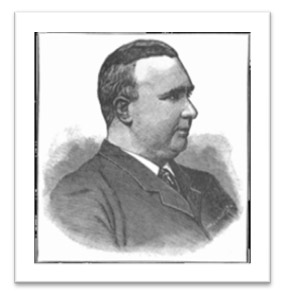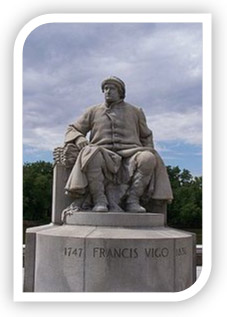PeoplePaul Dresser, Colonel Francis Vigo, Chauncey Rose, Hulman Family
Paul Dresser

Paul Dresser was born on April 22, 1859 in Terre Haute, Indiana under the name Johann Paul Dreiser, Jr. His younger brother, Theodore Dreiser, became a famous author. Their father wanted a priest in the family, and Paul studied at St. Meinrad's seminary for a while, but Paul’s passion was music. When he was 16 he ran away to join a traveling medicine show and later ended up in New York City. He composed more than 100 songs in his lifetime and even founded his own publishing house. In January 1906 in died in New York at his sister’s house. His life story is told in the movie “My Gal Sal” which was also the title of his most popular song. The other song that he is well known for is “On the Banks of the Wabash, Far Away,” which he published in 1897. It became the official state song of Indiana in 1913. In 1970 he was inducted into the Songwriters Hall of Fame.
Round my Indiana homestead wave the cornfields,
In the distance loom the woodlands clear and cool.
Often times my thoughts revert to scenes of childhood.
Where I first received my lessons, nature's school.
But one thing is missing in the picture,
Without her face it seems so incomplete.
I long to see my mother in the doorway
As she stood there years ago her boy to greet.
(Chorus)
Oh, the moonlight's fair tonight along the Wabash
From the fields there comes the breath of new mown hay.
Thro' the sycamores the candle lights are gleaming,
On the banks of the Wabash, far away.
Many years have passed since I strolled by the river,
Arm in arm with sweetheart Mary by my side.
It was there I tried to tell her that I loved her,
It was there I begged of her to be my bride.
Long years have passed since I strolled thro' the churchyard
She's sleeping there my angel Mary dear.
I loved her but she thought I didn't mean it.
Still I'd give my future were she only here.
(Chorus)
Colonel Francis Vigo
Terre Haute is the county seat of Vigo County which is named after Colonel Francis Vigo. Francis Vigo was born under the name Giuseppe Maria Francesco Vigo in Mondovi,  Italy in 1747. During his life he enlisted in the Spanish Army and was sent to Cuba and New Orleans. While he was in New Orleans he became interested in the fur trading business. In 1772, he established a fur trading business among the Native Americans in St. Louis. At the same time he was also a secret agent for the Spanish governor. In 1778, Vigo decided to help the Americans during the American Revolution. After George Rogers Clark captured Kaskaskia, Vigo began providing funding, supplies, and pertinent information to Clark. With this help from Vigo, Clark was able to recapture Vincennes in 1779. Vigo became an American citizen when he settled in Vincennes in 1783. In 1801, he petitioned the U.S. Congress for land in order to start what is now Vincennes University. In 1818 Vigo County Indiana was renamed after Colonel Vigo. The bell at the Vigo County Courthouse was bought using money that was provided from the government after he died as compensation for his efforts in the Revolutionary War. He lived to the old age of 89 and is buried in Vincennes.
Italy in 1747. During his life he enlisted in the Spanish Army and was sent to Cuba and New Orleans. While he was in New Orleans he became interested in the fur trading business. In 1772, he established a fur trading business among the Native Americans in St. Louis. At the same time he was also a secret agent for the Spanish governor. In 1778, Vigo decided to help the Americans during the American Revolution. After George Rogers Clark captured Kaskaskia, Vigo began providing funding, supplies, and pertinent information to Clark. With this help from Vigo, Clark was able to recapture Vincennes in 1779. Vigo became an American citizen when he settled in Vincennes in 1783. In 1801, he petitioned the U.S. Congress for land in order to start what is now Vincennes University. In 1818 Vigo County Indiana was renamed after Colonel Vigo. The bell at the Vigo County Courthouse was bought using money that was provided from the government after he died as compensation for his efforts in the Revolutionary War. He lived to the old age of 89 and is buried in Vincennes.
Chauncey Rose
 Chauncey Rose was born December 24, 1794 in Wethersfield, Connecticut. His parents were Scottish immigrants and had seven sons and one daughter. Two of Chauncey’s brothers were successful businessmen while Chauncey was an entrepreneur and philanthropist. Chauncey outlived all of his siblings. He ventured through many states including Kentucky, Tennessee, Indiana, Illinois, Alabama, and Missouri before settling in the Wabash Valley in 1817. For a few years he worked in the logging and milling industry but in 1824 he decided he did not want to leave Terre Haute again. Once he saw that Terre Haute would grow eastward from the Wabash River, he bought land in the area from Popular to Chestnut Streets and east to where Rose-Hulman is now located. Working as a merchant, he was popular, respected, and successful. He also established the railway system from Terre Haute to Chicago and Evansville. This stretch of railway was the safest in the country. While working on the railroad he realized that it was difficult to get technical training to come so far west and remain until his railroad was completed. So he decided to start the Terre School of Industrial Science which was later renamed Rose-Poytechnic Institute. He also provided funding for Indiana State Normal School which is now Indiana State University and Wabash College. Throughout his lifetime he donated $3,000,000 to various organizations ranging from orphanages to schools to other local charities. He died on August 13, 1877.
Chauncey Rose was born December 24, 1794 in Wethersfield, Connecticut. His parents were Scottish immigrants and had seven sons and one daughter. Two of Chauncey’s brothers were successful businessmen while Chauncey was an entrepreneur and philanthropist. Chauncey outlived all of his siblings. He ventured through many states including Kentucky, Tennessee, Indiana, Illinois, Alabama, and Missouri before settling in the Wabash Valley in 1817. For a few years he worked in the logging and milling industry but in 1824 he decided he did not want to leave Terre Haute again. Once he saw that Terre Haute would grow eastward from the Wabash River, he bought land in the area from Popular to Chestnut Streets and east to where Rose-Hulman is now located. Working as a merchant, he was popular, respected, and successful. He also established the railway system from Terre Haute to Chicago and Evansville. This stretch of railway was the safest in the country. While working on the railroad he realized that it was difficult to get technical training to come so far west and remain until his railroad was completed. So he decided to start the Terre School of Industrial Science which was later renamed Rose-Poytechnic Institute. He also provided funding for Indiana State Normal School which is now Indiana State University and Wabash College. Throughout his lifetime he donated $3,000,000 to various organizations ranging from orphanages to schools to other local charities. He died on August 13, 1877.
Hulman Family
The Hulman family is one of the wealthiest families in Terre Haute, Indiana. Herman Hulman came to Terre Haute in 1854 and later started Hulman and Company which later became Clabber Girl. Herman made contributions to St. Anthony’s Hospital and St. Benedict’s Catholic Church. The family grocery store was passed through the family to Anton Hulman Sr.; however Anton Sr. made his son, Anton Hulman Jr., work for a position in the family business. After graduating from Yale in 1924 Anton Hulman Jr. worked his way up in the ranks at Clabber Girl. He made it to manager of the whole company by the age of 30. His next goal was to make Clabber Girl the top baking powder in the country; he succeeded. He is also known for buying the Indianapolis Motor Speedway. Most people know him for the command on race day, “Gentlemen, start your engines”. The father and son duo made contributions to Rose Polytechnic Institute and Calvary Cemetery. When his father died in 1942, he gave $100,000 to help build an airport in Terre Haute, which was named Hulman Field. He was also elected to president of the Coca-Cola Bottling Company in 1965. He married Mary Fendrich and they had a daughter named Mari who was born on December 26, 1934. Together Mary and Anton made multiple contributions to Rose Polytechnic Institute, along with a contribution to Vigo County Office Buildings, Hulman Civic Center at Indiana State University, and the Terre Haute Jaycees. Money was also given to build a city golf course, a new fire station, a golf clubhouse, and a Student Union at ISU. Mary became chairman of the board of directors of the Indianapolis Motor Speedway after her husband died in 1977. She contributed money to the Indianapolis Museum of Art, Indiana State University and St. Mary-of-the-Woods College. Mari married Elmer George on April 29, 1957 and they had four children. Anton Hulman George was the only son and thus became heir to the family fortune. All four of the kids are now on the board of directors for the Indianapolis Motor Speedway. Anton Hulman George married Lisa Dawn Clark April 30, 1983 and the couple had one child, Anton Hulman George Jr. This marriage ended and he remarried to Laura Livvix who had a son from a previous marriage. They now also have a daughter named Lauren.
Others
There are many other people that have made a smaller impact on Terre Haute. They may not have helped with the development of Terre Haute or given millions of dollars to local schools and charities, but they lived here at some point in their life, and thus have impacted the area. Some of these people include the following: Senator Daniel W. Voorhees, who was nicknamed the "Tall Sycamore of the Wabash". Thomas H. Nelson was a minister to Chile and Mexico. John Palmer Usher was interior secretary under President Abraham Lincoln. Richard W. Thompson was dubbed the "Ancient Mariner of the Wabash" and was secretary of the navy under President Rutherford B. Hayes. Edward James Roye was the fifth president of Liberia. Claude Bowers was a well known historian and diplomat. Congressman Everett Sanders was Calvin Coolidge's secretary. Dr. Lyman Abbott was a clergyman, author, and editor of The Outlook magazine. Virginia Jenckes was the first woman from Indiana to be elected to the U. S. House of Representatives. Ellen Church Marshall became the world's first airline stewardess in 1930 after convincing United Air Lines that a woman stewardess would be very helpful. Between 1952 and 1965 Mrs. Marshall was an administrator of Union Hospital in Terre Haute. In 1979 Larry Bird was basketball’s College Player of the Year. He led ISU into the NCAA finals before signing a pro contract with the Boston Celtics. That contract gave him a wage that made him the highest paid rookie in professional sports history.
